
Halo 2 is a 2004 first-person shooter game developed by Bungie and published by Microsoft Game Studios for the Xbox console. Halo 2 is the second installment in the Halo franchise and the sequel to 2001's critically acclaimed Halo: Combat Evolved. The game features new weapons, enemies, and vehicles, another player character, and shipped with online multiplayer via Microsoft's Xbox Live service. In Halo 2's story mode, the player assumes the roles of the human Master Chief and alien Arbiter in a 26th-century conflict between the United Nations Space Command, the genocidal Covenant, and later, the parasitic Flood.

343 Guilty Spark, also known as just Spark, is a character in the military science fiction Halo franchise. 343 Guilty Spark plays a major role in the storyline of the original Halo video game trilogy: the character appears in Halo: Combat Evolved, Halo 2, and Halo 3, as well as the remakes of the first two games, Halo: Combat Evolved Anniversary, and Halo 2: Anniversary. 343 Guilty Spark is voiced by actor Tim Dadabo in all media.

Halo: The Fall of Reach is a military science fiction novel by Eric Nylund, set in the Halo universe, and acts as a prelude to Halo: Combat Evolved, the first game in the series. The book was released in October 2001 and is the first Halo novel. It takes place in the 26th century across several planets and locations. The novel details the events which led up to the game and explains the origins of the SPARTAN-II supersoldiers, narrating the story of the series protagonist, the Master Chief.
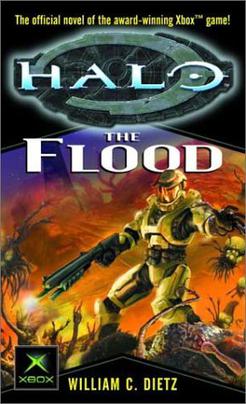
Halo: The Flood is a military science fiction novel by William C. Dietz, based on the Halo series of video games and based specifically on the 2001 video game Halo: Combat Evolved, the first game in the series. The book was released in April 2003 and is the second Halo novel. Closely depicting the events of the game, The Flood begins with the escape of a human ship Pillar of Autumn from enemy aliens known as the Covenant. When the Pillar of Autumn unexpectedly discovers a massive artifact known as "Halo", the humans must square off against the Covenant and a second terrifying force in a desperate attempt to uncover Halo's secrets and stay alive. Though the book roughly follows the same events of the Xbox game, featuring identical dialogue, Dietz also describes events not seen by the game's protagonist, the super-soldier Master Chief.

The Flood is a fictional parasitic alien lifeform and one of the primary antagonists in the Halo multimedia franchise. First introduced in the 2001 video game Halo: Combat Evolved, it returns in later entries in the series such as Halo 2, Halo 3, and Halo Wars. The Flood is driven by a desire to infect any sentient life of sufficient size; Flood-infected creatures, also called Flood, in turn can infect other hosts. The parasite is depicted as such a threat that the ancient Forerunners constructed artificial ringworld superweapons known as Halos to contain it and, as a last resort, to kill all sentient life in the galaxy in an effort to stop the Flood's spread by starving it.

Cortana is a fictional artificially intelligent character in the Halo video game series. Voiced by Jen Taylor, she appears in Halo: Combat Evolved and its sequels, Halo 2, Halo 3, Halo 4, Halo 5: Guardians and Halo Infinite. She also briefly appears in the prequel Halo: Reach, as well as in several of the franchise's novels, comics, and merchandise. During gameplay, Cortana provides backstory and tactical information to the player, who often assumes the role of Master Chief Petty Officer John-117. In the story, she is instrumental in preventing the activation of the Halo installations, which would have destroyed all sentient life in the galaxy.
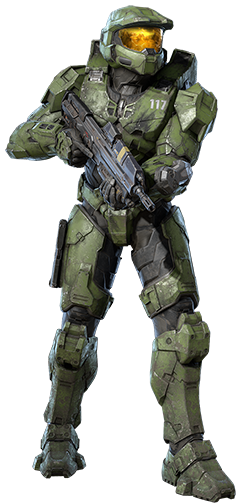
Master Chief is the protagonist in the Halo game series and spin-off media. Also known as Master Chief Petty Officer John-117, the character appeared in the 2001 video game Halo: Combat Evolved, a science fiction first-person shooter that became a long-running video game series. The character also appears in spin-off Halo media such as the 2012 film Halo 4: Forward Unto Dawn, the 2022 Halo television series, and several graphic novels and books.

Halo 3 is a 2007 first-person shooter video game developed by Bungie for the Xbox 360 console. The third installment in the Halo franchise following Halo: Combat Evolved (2001) and Halo 2 (2004), the game's story centers on the interstellar war between 26th-century humanity, a collection of alien races known as the Covenant, and the alien parasite known as the Flood. The player assumes the role of the Master Chief, a cybernetically enhanced supersoldier, as he battles the Covenant and the Flood. In cooperative play, other human players assume the role of allied alien soldiers. The game features vehicles, weapons, and gameplay elements familiar and new to the series, as well as the addition of saved gameplay films, file sharing, and the Forge map editor—a utility which allows the player to perform modifications to multiplayer levels.
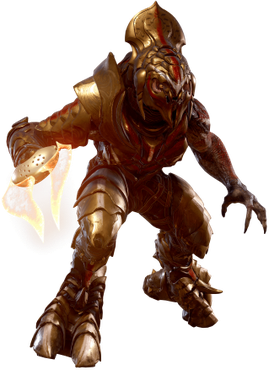
In the Halo universe, an Arbiter is a ceremonial, religious, and political rank bestowed upon Covenant Elites. In the 2004 video game Halo 2, the rank is given to a disgraced commander named Thel 'Vadam as a way to atone for his failures. Although the Arbiter is intended to die serving the Covenant leadership, the High Prophets, he survives his missions and the Prophets' subsequent betrayal of his kind. When he learns that the Prophets' plans would doom all sentient life in the galaxy, the Arbiter allies with the Covenant's enemies (humans) and stops the ringworld Halo from being activated. The Arbiter is a playable character in Halo 2 and its 2007 sequel Halo 3. The character also appears in Halo 5: Guardians and additional expanded universe material. A different Arbiter, Ripa 'Moramee appears in the 2009 real-time strategy game Halo Wars, which takes place 20 years before the events of the main trilogy.
Halo is a military science fiction media franchise, originally developed and created by Bungie and currently managed and developed by 343 Industries, part of Microsoft's Xbox Game Studios. The series launched in 2001 with the first-person shooter video game Halo: Combat Evolved and its tie-in novel, The Fall of Reach. The latest main game, Halo Infinite, was released in late 2021.

The first-person shooter video game Halo 3 was the focus of an extensive marketing campaign which began with the game's developer, Bungie, announcing the game via a trailer at the Electronic Entertainment Expo in May 2006. Microsoft, the game's publisher, planned a five-pronged marketing strategy to maximize sales and to appeal to casual and hard-core gamers. Bungie produced trailers and video documentaries to promote the game, partnering with firms such as Digital Domain and Weta Workshop. Licensed products including action figures, toys, and Halo 3-branded soda were released in anticipation of the game; the franchise utilized more than forty licensees to promote the game, and the advertising campaign ultimately cost more than $40 million.

Halo 4 is a 2012 first-person shooter video game developed by 343 Industries and published by Microsoft Studios for the Xbox 360 video game console. Halo 4's story follows a cybernetically enhanced human supersoldier, Master Chief, and his artificial intelligence construct Cortana, as they encounter unknown threats while exploring an ancient civilization's planet. The player assumes the role of Master Chief who battles against a new faction that splintered off from remnants of the Covenant, a former military alliance of alien races, as well as a new enemy: mechanical warriors of the Forerunner empire known as the Prometheans. The game features a new selection of weapons, enemies, and game modes not present in previous titles of the series.

Halo 3: ODST is a 2009 first-person shooter game developed by Bungie and published by Microsoft Game Studios. The fifth installment in the Halo franchise as a side game, it was released on the Xbox 360 in September 2009. Players assume the roles of United Nations Space Command Marines, known as "Orbital Drop Shock Troopers" or ODSTs, during and after the events of Halo 2. In the game's campaign mode, players explore the ruined city of New Mombasa to discover what happened to their missing teammates in the midst of an alien invasion. In the "Firefight" multiplayer option, players battle increasingly difficult waves of enemies to score points and survive as long as possible; Halo 3's multiplayer is contained on a separate disc packaged with ODST.

Halo Wars is a real-time strategy (RTS) video game developed by Ensemble Studios and published by Microsoft Game Studios for the Xbox 360 video game console. It was released in Australia on February 26, 2009; in Europe on February 27; and in North America on March 3. The game is set in the science fiction universe of the Halo series in the year 2531, 21 years before the events of Halo: Combat Evolved. The player leads human soldiers aboard the warship Spirit of Fire in an effort to stop an ancient fleet of ships from falling into the hands of the genocidal alien Covenant.

Halo: Reach is a 2010 first-person shooter video game developed by Bungie and published by Microsoft Game Studios, originally for the Xbox 360. The sixth installment in the Halo series and a direct prequel to Halo: Combat Evolved, Reach was released worldwide in September 2010. The game takes place in the year 2552, where humanity is locked in a war with an alien theocracy known as the Covenant, which seeks to exterminate humanity. Players play as Noble Six, a member of an elite squad of supersoldiers, known as Noble Team, attempting to stage a defense of the human world known as Reach, which falls under Covenant attack. The game was the last in the series to be developed by Bungie.
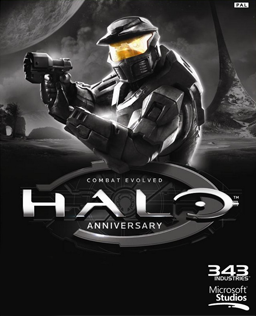
Halo: Combat Evolved Anniversary is a 2011 first-person shooter video game developed by 343 Industries, Saber Interactive, and Certain Affinity. It is a remake of Halo: Combat Evolved (2001), developed by Bungie. Publisher Microsoft announced Anniversary alongside Halo 4 at the 2011 Electronic Entertainment Expo. It was released in November 2011, the 10th anniversary of the original Halo, for the Xbox 360 console, and re-released as part of Halo: The Master Chief Collection for the Xbox One in November 2014. A Windows version was released in March 2020.
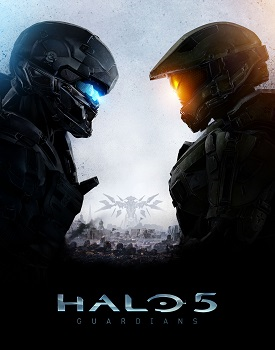
Halo 5: Guardians is a 2015 first-person shooter video game developed by 343 Industries, published by Microsoft Studios, and released worldwide for the Xbox One game console on October 27, 2015. The plot follows two fireteams of human supersoldiers: Blue Team, led by Master Chief, and Fireteam Osiris, led by Spartan Locke. When Blue Team goes absent without leave to track down the artificial intelligence construct Cortana, Master Chief's loyalty is called into question and Fireteam Osiris is sent to retrieve him.

Halo: The Master Chief Collection is a compilation of first-person shooter video games in the Halo series. The collection was released in November 2014 for the Xbox One, and later ported to Microsoft Windows and the Xbox Series X/S. The collection was developed by 343 Industries in partnership with other studios and was published by Xbox Game Studios. The collection includes Halo: Combat Evolved Anniversary, Halo 2: Anniversary, Halo 3, Halo 3: ODST, Halo: Reach, and Halo 4.

Halo Infinite is a 2021 first-person shooter game developed by 343 Industries and published by Xbox Game Studios. It is the sixth mainline installment in the Halo series, following Halo 5: Guardians (2015). The game's campaign follows the human supersoldier Master Chief and his fight against a mercenary organization, known as the Banished, on the Forerunner ringworld Zeta Halo. Unlike previous mainline entries in the series, the multiplayer portion of the game is free-to-play.



















